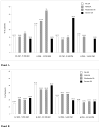Sleep apnea prevalence in acute myocardial infarction--the Sleep Apnea in Post-acute Myocardial Infarction Patients (SAPAMI) Study
- PMID: 25064202
- PMCID: PMC4249636
- DOI: 10.1016/j.ijcard.2014.06.020
Sleep apnea prevalence in acute myocardial infarction--the Sleep Apnea in Post-acute Myocardial Infarction Patients (SAPAMI) Study
Abstract
Background: While sleep apnea (SA) might be a modifiable cardiovascular risk factor, recent data suggest that SA is severely underdiagnosed in patients after acute myocardial infarction (MI). There is limited evidence about day-night variation of onset of MI on dependence of having SA. We therefore investigated the prevalence of SA and examined the day-night variation of onset of MI in acute MI patients.
Methods: We prospectively studied 782 consecutive patients admitted to the hospital with the diagnosis of acute MI. All subjects underwent sleep evaluations using a portable device after at least 48 h post-admission. Using the apnea-hypopnea index (AHI), groups were defined as patients without SA (<5 events/h), mild SA (5-15 events/h), moderate SA (15-30 events/h), and severe SA (≥ 30 events/h).
Results: Almost all patients (98%) underwent urgent coronary angiography and 91% of patients underwent primary PCI. Using a threshold of AHI ≥ 5 events/h, SA was present in 65.7% of patients after acute MI. Mild SA was present in 32.6%, moderate in 20.4% and severe in 12.7%. The day-night variation in the onset of MI in all groups of SA patients was similar to that observed in non-SA patients. From 6 AM to 12 PM, the frequency of MI was higher in both SA and non-SA patients, as compared to the interval from 12 AM to 6 AM (all p<0.05).
Conclusion: There is a high prevalence of SA in patients presenting with acute MI. Peak time of MI onset in SA patients was between 6 AM and noon, similar to that in the general population. Whether diagnosis and treatment of SA after MI will significantly improve outcomes in these patients remains to be determined.
Keywords: Acute myocardial infarction; Day–night variation; Prevalence; Sleep apnea.
Copyright © 2014 Elsevier Ireland Ltd. All rights reserved.
Figures
Comment in
-
Acute myocardial infarction and sleep apnea.Int J Cardiol. 2015 May 6;187:486-7. doi: 10.1016/j.ijcard.2015.03.389. Epub 2015 Mar 28. Int J Cardiol. 2015. PMID: 25846659 No abstract available.
-
Response to the Letter of Dr. Tomoyuki Kawada, "Acute Myocardial Infarction and Sleep Apnea".Int J Cardiol. 2015 Sep 15;195:51-2. doi: 10.1016/j.ijcard.2015.05.051. Epub 2015 May 12. Int J Cardiol. 2015. PMID: 26022799 No abstract available.
References
-
- Wolk R, Kara T, Somers VK. Sleep-disordered breathing and cardiovascular disease. Circulation. 2003;108(1):9–12. - PubMed
-
- Mehra R, Principe-Rodriguez K, Kirchner HL, Strohl KP. Sleep apnea in acute coronary syndrome: high prevalence but low impact on 6-month outcomes. Sleep Med. 2006;7(6):521–528. - PubMed
-
- Lee CH, Khoo SM, Tai BC, et al. Obstructive sleep apnea in patients admitted for acute myocardial infarction. Prevalence, predictors, and effect on microvascular perfusion. Chest. 2009;135(6):1488–95. - PubMed
-
- Lopez-Jimenez F, Sert Kuniyoshi FH, Gami A, Somers VK. Obstructive sleep apnea: Implications for cardiac and vascular disease. Chest. 2008;133(3):793–804. - PubMed
-
- Skinner MA, Choudhury MS, Homan SD, Cowan JO, Wilkins GT, Tailor DR. Accuracy of Monitoring for Sleep-Related Breathing Disorders in the Coronary Care Unit. Chest. 2005;127(1):66–71. - PubMed
Publication types
MeSH terms
Grants and funding
LinkOut - more resources
Full Text Sources
Other Literature Sources
Medical
Miscellaneous




